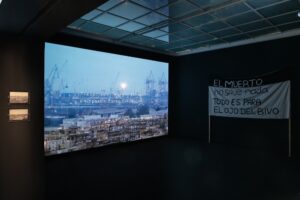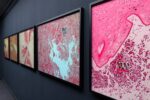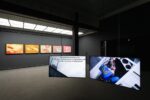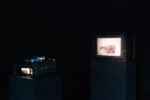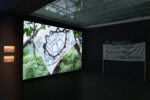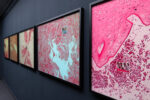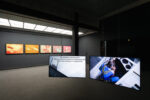TRANSGRESSIONS OF THE REAL
Kush Badhwar , Yara Haskiel , Ash Moniz , Mykola Ridnyi, curated by Andrei Siclodi
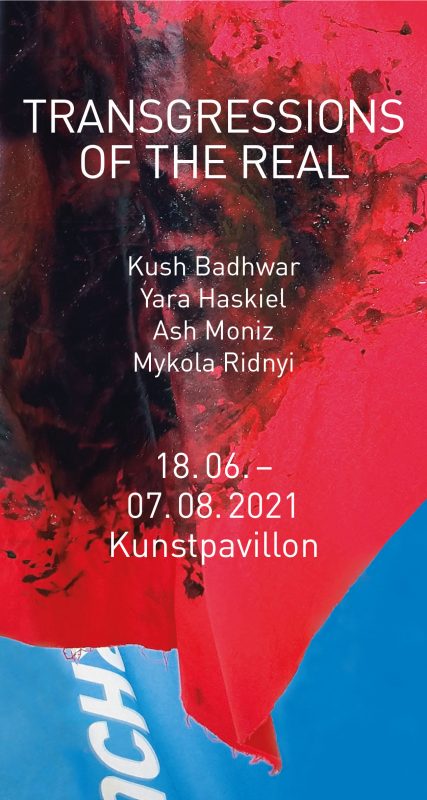
Kush Badhwar
Yara Haskiel
Ash Moniz
Mykola Ridnyi
An exhibition of the Büchsenhausen Fellowship Program for Art and Theory 2020-21
Curated by Andrei Siclodi
OPENING Thursday 17 June 2021, 18.00 – 22.00
The visit of the exhibition is possible only in accordance with the current legal COVID-19 regulations.
In Transgressions of the Real, the participants of the Fellowship Program 2020-21 in Büchsenhausen present works that hypostatize the real as socio-political scenarios of the present. The phenomenon of “flags of convenience” and the transformations concerning legislation and employment associated with this “territorial expansion” of national states, the representation of violence without reproducing violent images, counter-narratives of the achievement of statehood in regard to Telangana, India’s youngest state, as well as strategies of commemmoration at socially contested sites in Thessaloniki constitute the thematic focus upon which the artistic works have been developed.
Lacan understood the real as “something that absolutely resists symbolization”1 and at the same time is ejected from the ego.2 Thus, this iconoclastic conception of the “unimaginable” does not tolerate any engagement beyond the constructed reality. And yet, it continuously resonates within, as its imagination would be then just as impossible. Consequently, the works assembled in this exhibition can be viewed in at least two ways which may well overlap. On the one hand, the exhibition refers to a violation of the taboo, an unforeseen transgression of the real, capable of shaking reality in its naturalized fixation, which in turn enables disarrangements of perception. On the other hand, it is an attempt to hold up a broken mirror to hegemonic narratives of contemporary social order that are still entrenched in the myth of the national state. In combination with reflections, shadows and fragments of largely neglected aspects of these orders, this mirror can reveal a possibly unexpected potential of emancipatory knowledge.
Upon entering the exhibition, which has transformed the space of the Kunstpavillon into a walk-in pseudo-camera Obscura, one encounters Ash Moniz’s video installation To Be Inconvenienced. On two low-hanging displays, a fable-like narration of vacant architectures, lost triumphs, the harvesting of sovereignties and unlocalizable jurisdictions is told. In short video sequences and dialogues, a complex picture of a quasi-irresolvable condition unfolds in an as-if mode, constituted predominantly against a mountainous setting, in order to speak of a situative complex at the other end of the geo-economic spectrum – the phenomenon of the flags of convenience. The global trade economy heavily depends on this capitalist logic that operates since the end of the Second World War. Outflagging of cargo ships stands for exchanging the flag of one national state with another (such as Panama or Liberia, to name but two of the best-known examples) in order to save costs. Dislocated areas of a sovereign territory are thus subjected to a regime of lenient registration requirements and poor labor conditions, turning them into “floating buildings” for a high seas proletariat. Ash Moniz addresses this situation with a forensic-like analysis in close exchange with juridic experts on maritime labor sovereignty. In an attempt to comprehend the exploitative absurdity of the naturalized status quo in all its complexity, the artist stages situations and dialogues that are, at first glance, geographically impossible, but accurate from a legal point of view.
Mykola Ridnyi’s work Speck in the Eye also examines a perceived impossibility: the difficulty of dealing artistically with images of violence without reproducing the visual violence they contain. In a series of works created in recent years, the Ukraine-based artist has addressed the problem of the increasing amount of violence in the media and in everyday life in Ukraine. The photo installation, developed together with an audio work in the course of his fellowship in Büchsenhausen, continues this investigation. Here, Mykola Ridnyi has applied small “patches” to five large-format pictures that show geological sediments-like looking structures: These stickers document so-called “blind protests” that took place all over the world – among others in Chile, Egypt, Hong Kong, Kashmir, Palestine or Georgia – and became known as demonstrations in solidarity with victims of police or paramilitary brutality, in consequence of which they had lost their eyes or suffered from severe eye injuries. Although the pictures, at first glance, resemble contingent abstractions, they are microscopic images of the eye structure, showing injuries caused by external forces. These ophthalmological samples provide evidence of the real consequences of state violence, which is inscribed in the organic structure of the citizens’ bodies. Ridnyi transforms these quasi-physical abstractions into a public space by pasting images of solidarity with the victims of violence taken from mass media. Two radiophonic audio pieces enhance the work’s media spectrum and collage acoustically with the images.
In his installation and the Rain Trees… Kush Badhwar also employs the method of collage, though in a different form. What seems to be a simple technical overlapping of a video on a vintage CRT monitor with the projection of analogue slides on its screen turns out to be a complex examination of imagery and historicity, of the potential of iterative seeing and the shifting of historical consciousness when “grand narratives” are questioned. The project owes its name, Rain Trees (Enterlobium Saman), to the species’ reference in a small volume on the history of Osmania University in Hyderabad, India. However, the book omits the politics that has been pursued on the university campus over several generations and which, among other things, contributed to the creation of Telangana, India’s 29th and youngest state, in 2014. Badhwar’s project began as research in archives, libraries and personal collections of material relating to the founding of Telangana and the preceeding long-lasting political movements that led to and catalyzed this process. In the course of this research, Badhwar chanced upon a collection of materials of a professor of ancient Indian history and archaeology. Shortly after that, he found himself in possession of this collection. The ambivalence of the narrative modes, connecting as well as differentiating the professor’s collection and the official foundation of the state forms the basis of this artistic investigation.
In the course of the Fellowship in Büchsenhausen, Badhwar developed the project’s first materialization, which can be now seen in the exhibition. In terms of both form and content, the installation enters into a critical dialogue with the professor’s photo and video material, sometimes in combination with the artist’s own footage. The binarity originally inherent in the relationship between the narrative of the founding of the state versus possible alternative historical scenarios is reflected in the loops, overlaying two perspectives – that of the professor and that of the artist – with the same images and sequences. At the same time, the visually appealing, multi-layered relationship between the electronic and the literally shone-through images complicates the supposed unambiguity and, thus, initiates a reflexive thought process that enables new perspectives.
The fourth contribution to the exhibition, Yara Haskiel‘s video Precarious Twilight Zones, examines the historiography of the unwritten that manifests itself beyond evident cracks in the collective memory and makes traumatic as well as traumatising experiences and events discernible in the materiality of social space. Matei Bellu writes, “Precarious Twilight Zones tells the story of an erasure, an annihilation, an absence. The history of the Jewish Thessaloniki remains inscribed in the memories of the living and the material testimony of the stones. The camera follows a young protagonist as she uses her body to reassemble the urban space with a web of connections, encircling the fragmented and scattered absence and searching for visibility that rearticulates the past via material traces and appearances in the present. In doing so, both the continuities and the cracks of the nationalist as well as modernist Hellenisation project become perceivable, the latter which is carried forward in the neoliberal dispossession and violence that, to this day, ‘keeps piling wreckage’. Her dreamlike walk through the city is rhythmized by a seemingly never-ending sunset – that could also be interpreted as a sunrise – in the light of which the space appears so flat, that not even her body leaves a trace of its shadow.
Against the cleansed voids of Hellenistic historiography and modernist urban planning, purged of entanglements and contradictions, the film develops its own poetic instruments of witnessing, writing and reading. Precarious Twilight Zones rejects a coherent discourse of self-contained and independent narratives, allowing the traces sedimented in the present to find their own language, in which the construction of a Greek nation superimposes present-day neoliberal precarity and austerity. A historic topography of vulnerable surfaces emerges, as well as of layered temporalities and transitional zones, in which material reality itself seems to be inscribed by affects.”
In addition to the film, two other pieces are on display in the exhibition: a banner used in the film with the Ladino saying “The dead knows nothing, everything is in the eye of the living“, along with two historical postcards: a photograph of the Muslim cemetery in Thessaloniki, mistakenly described as “Jewish cemetery“, and a view of Thessaloniki Bay at twilight, overlooked from the actual Jewish cemetery.
Andrei Siclodi
1 Seminar 1. Meeting of February 17, 1954; Miller/Hamacher, p.89
2 https://lacan-entziffern.de/reales/25048-das-reale
Kush Badhwar’s project is also supported by the Government of New South Wales Australia under the funding program Create NSW – Arts, Screen & Culture.
Yara Haskiel’s project is also supported by DAGESH – Jewish Art in Context, Asylum Arts and Allianz Kulturstiftung.
![]()
![]()
![]()
![]()
Artists:
Kush BADHWAR is an artist and filmmaker operating across media, art, cinematic and other social contexts. He is interested in the ecology of sound and image across stretches of time and political change. He believes in the potential of research and collectivity. To this end, he has worked closely with wala, Word Sound Power, Frontyard Projects and Khanabadosh.
Selected screening or exhibition of his work includes at Addis Video Art Festival, the Flaherty Seminar, Tallinn Photomonth Biennale, Five Million Incidents, Experimenta Bangalore, Sarai Reader 09, Videobrasil, and Forum Expanded, Berlinale. He has also undertaken Pad.ma’s Fellowship for Experiments with Video Archives and India Foundation of the Arts Archival Fellowship.
https://waydk.com/
Yara HASKIEL is a video artist and researcher. She studied Experimental Film and Art and Media at the University of Arts in Berlin and Hamburg with Hito Steyerl, Heinz Emigholz and Gerd Roscher. She holds a Master in Museology and Critical Theory from the Autonomous University of Barcelona. In 2014-15 she took part in the Independent Studies Program (PEI) at the Museum for Contemporary Art (MACBA) in Barcelona. Her collaborative exhibition project Personal Geographies was realized in Berlin and Belgrade (2016-2018). In 2019, her research project Assembly of Sleepless Matter was granted with the Artist Research Fellowship by the Senate Department for Culture and Europe, Berlin. Currently, she is a PhD scholar of the Rosa-Luxemburg-Foundation and at the Visual Culture Department at Goldsmiths, London.
Central themes of her work are the connections between memory and (dis-) placement of minor and forgotten narratives and their trans-generational affective constellations. Further, she focuses on micro politics and its precarities. Yara Haskiel generates video essays and multi-screen installations that embrace reflexivity by experimenting with video diary, found footage and new media.
https://vimeo.com/haskielproductions
Ash MONIZ is a multi-disciplinary artist whose practice spans performance, installation, video and film. Their research deals with the securitization of supply-chain logistics and its labor. Through interviews and performative collaborations, they work with the ways that stories are told, deconstructing the temporality of narrative structure in Just-In-Time transportation logistics. The word “plot” and its historical etymological connection between land ownership and the arrangement of dramatic structure on a stage, is foundational to how Moniz approaches the intersection of cartography and scenography. Working with artifacts, documents, and found media that span from London 1792 to Sokhna 2013, Moniz “plots” systematic procedures of motion within the flows of value, subject hood, and causality.
Along with a BA from OCAD University (Toronto), Moniz has participated in independent study programs such as Raw Academy (Dakar, Senegal), the Harun Farocki Institute (Berlin, Germany) and Mass Alexandria (Alexandria, Egypt). Moniz’s exhibitions include solo shows at Townhouse Gallery (Cairo), Sishang Museum (Beijing), and Birch Contemporary (Toronto); duo exhibitions at Kelder Projects (London) and Pari Nadimi (Toronto); and group shows at Forum Expanded | Berlinale (Berlin), the Dakar Biennale (Dakar), and the Minsheng Museum (Shanghai) [among others]. They teach at the Cairo Institute for Liberal Arts and Sciences, and write art criticism for the Egyptian online-magazine Mada Masr. Moniz was a member of the artist collective ADL from 2014-2018, and were the assistant curator of the AMNUA Museum in Nanjing, China, in 2014/15.
Mykola RIDNYI is an artist, filmmaker and essayist based in Kyiv, Ukraine. He works across media, ranging from early political actions in public space to the fusion of site-specific installations, photography and the moving image which constitute the current focus of his practice. In recent films he experiments with nonlinear montage, and a collage of documentary and fiction. His way of reflecting social and political reality draws on the contrast between fragility and resilience of individual stories and collective histories. A connection with alternative times and phenomena, the influence of the past to the present and future, and the pressing polemic of manipulating historical memory born out of contemporary political agendas are among the main issues revealed in his engagements, initiatives, and projects.
Ridnyi has been a founding member of the SOSka group – an art collective originated from Kharkiv, Ukraine. He is a contributing editor of Prostory, an online magazine about art and society. His works has been exhibited in Venice biennale for contemporary art, The School of Kyiv – Kyiv biennale, Pinakothek der Moderne in Munich, daad galerie in Berlin, Transmediale in Berlin, Zentrum fur Kunst und Media in Karlsruhe, Galerie fur Zeitgenossische Kunst in Leipzig, Museum of Modern Art in Warsaw, Bonniers konsthall in Stockholm and others. He has been a scholar of Akademie der Kunst in Berlin, Iaspis in Stockholm, Gaude Polonia in Krakow and others.
http://www.mykolaridnyi.com/
